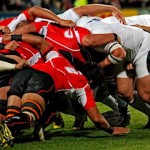 When I read this ‘oldish’ article I decided that our resident scrum gurus would love it. Here it is courtesy of the Rugby Site’s Waterboy, Brendon Ratcliffe.
When I read this ‘oldish’ article I decided that our resident scrum gurus would love it. Here it is courtesy of the Rugby Site’s Waterboy, Brendon Ratcliffe.
When I was coaching at Northampton just after the turn of the century (21st thank you), we had a prop called Renaud Peillard who had a taste for destroying opposition tightheads. Peillard called it ‘door open.’ A prop who was foolish enough to come in with a high right shoulder could expect Peillard to rip the door off its hinges.
A tighthead’s raised right arm, ‘la porte ouverte’, left him vulnerable to Peillard’s attack. But what, I wondered, did Renard do when the door was closed. Peillard looked at me as if it was the dumbest question that he had ever been asked.
Only the French can shrug their faces. Imbecile! With infinite patience Peillard eventually told me: “If I cannot go ‘ere, I will go ‘ere and ‘ere.” When the door was bolted, ‘ere and ‘ere turned out to be the neck and the bridge of the nose. For the Renaud Peillards of this world, the scrummage is a primal battle of manhood.
Peillard used to talk about the spirit of the scrum. It binds men together. France had Aerospace build a robot scrum, a mean machine, presumably because human beings were no longer hard enough to practise against. When France came good at the World Cup it was because William Servat and Nicolas Mas – ‘the operator’ as Steve Thompson calls him – came back into the side.
The scrummage matters. At the start of my coaching career I asked Denis Brown, a wily old front row forward who was in charge of the pack at the Chiefs, to teach me stuff about this dark place. He said: “You have to understand that 95% of it is really simple, basic stuff. The trouble is that people try to teach the complicated 5%, before they have got the 95% right.”
First things first. Get your feet straight. It’s very hard to push if your base is at an angle. Think of a machine with a series of levers. The most efficient way of generating force is when those levers are in a straight line. So get the feet aligned, bend from the knees – not from the hips – and keep those main levers as straight as possible. And get your bum back – we call it ‘the duck arse’ position – to lock out the force.
These things really matter and they take a lot of practice. There may only be ten scrums in the game, but if you can gain physical dominance there, then it transfers to the breakdown and every other part of the game. You have to take the opposition pack’s mana. It is a huge thing for the French. Robert Paparemborde and Gerard Cholley are legends of Les Bleus.
Kenny Milne, the former Scotland hooker, tells the story of when the Scots were in Paris and he struck for the French ball. He ran from the scrum in fear for his life but nothing happened. So he tried it again. This time Jean-Pierre Garuet, a French prop who looked like a gangster off the Marseille docks, grabbed Milne by the throat and said: “Non.” And “non” it was from that moment on. No argument.
There was a time when the set piece had been lost from the New Zealand game and maybe it is still lost to the Australians. But John Mitchell, after his time with Clive Woodward, brought the philosophy back to New Zealand. Graham Henry, Steve Hansen and Wayne Smith, other northern travellers, continued the missionary work.
The mana of the scrummage is a big part of the All Blacks again. It should be a big part of any rugby team.
Hear hear.